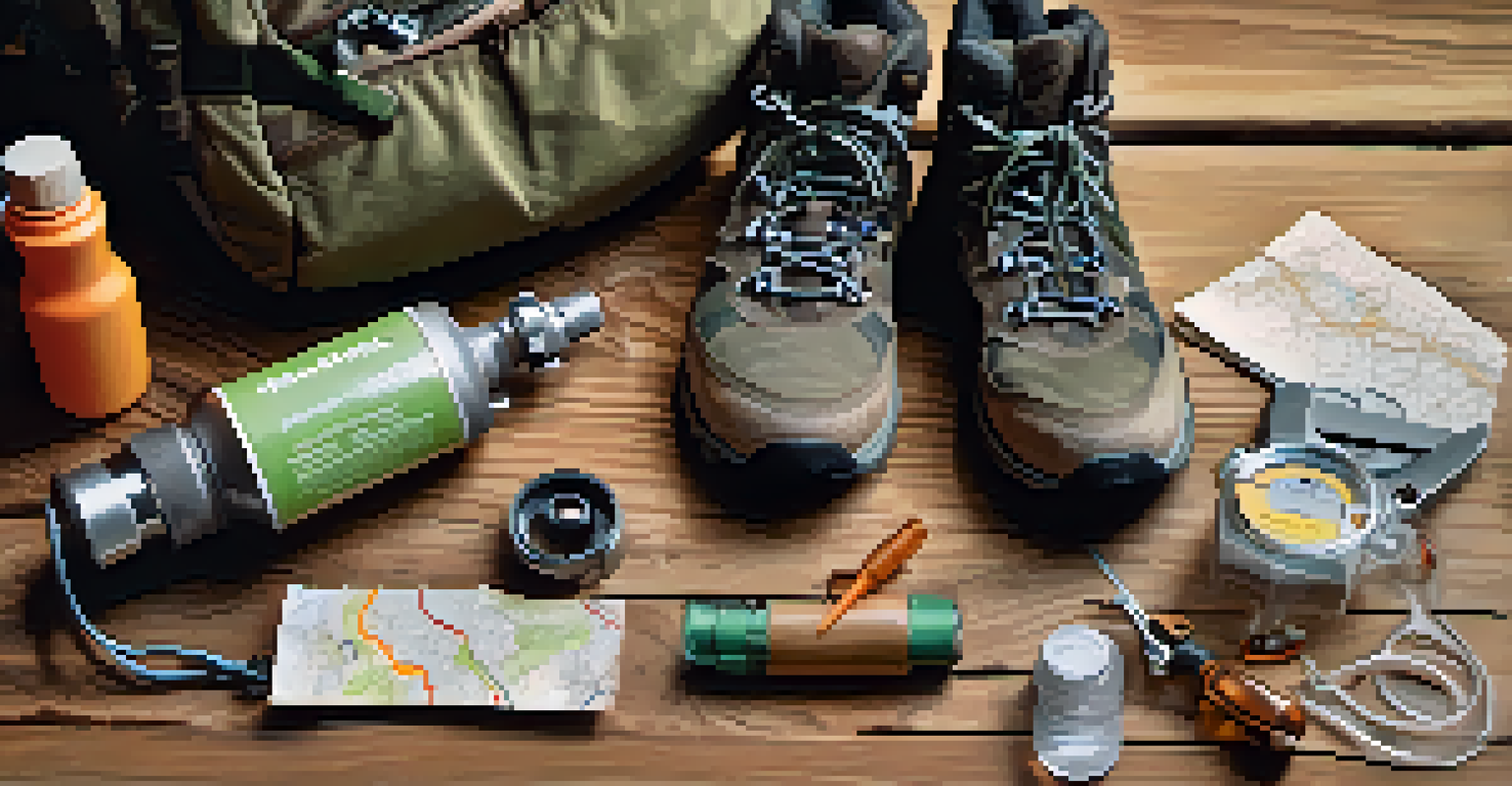How to Stay Safe While Hiking: Self Defense Tips

Understand Your Surroundings Before You Hit the Trail
Before setting out on your hiking journey, it's crucial to familiarize yourself with the area. Research the trail, weather conditions, and any potential hazards, such as wildlife or rough terrains. Knowing the specific characteristics of the area will help you stay alert and prepared.
The mountains are calling and I must go.
You can also check local hiking forums or connect with fellow hikers who may have recent insights about the trail. Additionally, consider using apps that provide information on trail conditions and safety updates. This knowledge will empower you to make informed decisions.
Finally, always let someone know your hiking plans, including your expected return time. This simple act of communication can be a lifesaver if anything goes wrong during your adventure.
Dress Appropriately for Safety and Comfort
Wearing the right gear can significantly impact your safety while hiking. Opt for sturdy, comfortable footwear that provides good support to prevent slips and falls. Additionally, choose clothing that is suitable for the weather and allows for ease of movement.

Don’t forget essentials like a hat and sunscreen to protect your skin from the sun. Bright or reflective clothing can also increase your visibility, especially in crowded trails or low-light conditions. This not only enhances your safety but helps others spot you easily.
Know Your Trail and Surroundings
Familiarizing yourself with the trail, weather, and potential hazards is essential for a safe hiking experience.
Lastly, consider carrying a lightweight backpack with necessary supplies, such as water, snacks, and a basic first aid kit. Being well-prepared can help you handle unexpected situations more effectively.
Stay Alert and Trust Your Instincts While Hiking
When you're out in nature, staying alert is key to your safety. Pay attention to your surroundings, including other hikers and any unusual sounds. If something feels off, don’t hesitate to trust your instincts and take action, whether that means changing your route or turning back.
In every walk with nature, one receives far more than he seeks.
Being aware of your environment also means keeping an eye on wildlife. Understand which animals inhabit the area and what to do if you encounter them. Avoid approaching or feeding wild animals, as this can provoke unexpected incidents.
Finally, maintain a steady pace and avoid distractions, like excessive phone use or listening to music through headphones. Staying engaged with your surroundings can help you spot potential threats early.
Learn Basic Self Defense Techniques for Hikers
Knowing some basic self-defense techniques can boost your confidence while hiking. Simple moves, like blocking, escaping holds, or using your body weight to your advantage, can be effective in a threatening situation. Consider taking a self-defense class to acquire these essential skills.
Practice these techniques regularly so they become second nature. It’s not just about physical strength; understanding how to use your surroundings, such as trees or rocks, can give you an edge if needed. Remember, self-defense is about protection, not aggression.
Dress for Comfort and Safety
Wearing appropriate gear and carrying necessary supplies can significantly enhance your safety and enjoyment while hiking.
Additionally, familiarize yourself with local laws regarding self-defense. Knowing your rights can help you make informed decisions if you ever find yourself in a dangerous scenario while hiking.
Travel with a Buddy for Added Safety
One of the simplest yet most effective ways to enhance your safety while hiking is to travel with a buddy. Having a friend along not only provides companionship but also acts as an extra set of eyes and ears. You can look out for each other and share responsibilities, like navigation and decision-making.
If hiking alone is unavoidable, let someone know your plans and check in with them at predetermined times. This way, someone will be aware if you’re delayed or encounter trouble. Many hikers also find it comforting to have a hiking partner for motivation and support.
In addition, consider joining a hiking group or community. These groups can offer camaraderie and valuable tips on safety, making your outdoor experience even more enjoyable.
Equip Yourself with Safety Tools and Gadgets
Carrying safety tools can provide peace of mind during your hikes. A whistle, for example, is lightweight and can be heard from a distance, making it an effective way to signal for help. Personal alarms are another great option, offering loud sounds to attract attention in emergencies.
A multi-tool or a small knife can also come in handy for various situations, whether it's preparing food or handling first aid. Consider a flashlight or headlamp, especially if there's a chance you might be out after dark. Better to be prepared than caught in the dark!
Stay Alert and Trust Your Instincts
Being aware of your surroundings and trusting your gut feelings can help you navigate potential threats in the wilderness.
Lastly, don’t forget about technology. Apps that track your location or provide emergency contacts can be invaluable. Investing in a portable phone charger can ensure your devices stay powered up, keeping you connected even in remote areas.
Know Your Escape Routes and Emergency Procedures
While hiking, it's essential to have a plan for emergencies. Before setting off, identify potential escape routes and safe areas along your trail. Familiarizing yourself with landmarks can help you navigate back to safety if needed.
In case of an emergency, knowing basic first aid procedures can also be lifesaving. Consider taking a first aid course to learn how to handle common injuries or situations you might encounter while hiking, like sprains or bites.

Lastly, if you find yourself in a dangerous situation, don’t hesitate to call for help. Familiarize yourself with how to signal for assistance and be prepared to provide your location clearly. The more prepared you are, the better you can handle unexpected challenges.